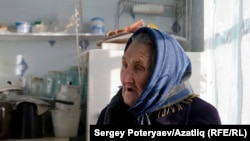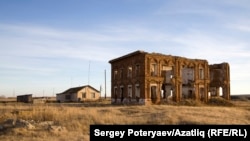Ramil Mukhamedyarov looks out at the placid waters of the Techa River in Russia's Ural Mountains.
He says for kids in Novoye Muslyumovo, a mostly ethnic Tatar village, it serves as the local swimming hole. Cattle often lap at its waters and graze near its banks.
It sounds idyllic, but there's a problem. For decades, radioactive waste has been dumped or seeped into the Techa.
Nearby is the Mayak nuclear installation, one of the largest nuclear complexes in the world, now run by Russian state nuclear regulator and operator Rosatom to reprocess spent nuclear fuel. In 1957, a nuclear accident at Mayak contaminated 20,000 square kilometers and affected an estimated 270,000 people.
It was one of history's worst obscure nuclear tragedies. Since Mayak was a "secret site" and nearby Chelyabinsk a "closed town," Soviet authorities didn't flinch. They initially released no details of what would become known as the Kyshtym disaster, named after the nearest town actually listed on maps.
It was only in the 1990s, after the collapse of the Soviet Union, that the scale of the disaster emerged. And only in 2009, more than a half-century after the incident, were residents of Muslyumovo -- the village worst-hit by the spillage at Mayak -- relocated.
Mukhamedyarov and his neighbors were given a choice: a new home or a 1 million-ruble (about $30,000 at the time) payout. Announced in the wake of a visit to the area by then-Russian President Dmitry Medvedev, the program was riddled with corruption, however. Many of those who opted for the cash never saw most of it, and those who picked alternative housing were relocated just 2 kilometers down the road in what would become Noveye, or New, Muslyumovo, still well within the contamination zone.
Nice On The Surface...
Compared to other Russian villages of similar size, Noveye Muslyumovo has its appeal. The roads are smooth and paved. The rows of nearly identical, red-roofed, clapboard houses are tidy and clean. There's a new school and other facilities. A poultry-processing facility, despite the smell wafting from it, provides locals with jobs.
Plus, living in an irradiated zone means residents receive some additional benefits from the federal government. Villagers get 500 rubles a month ($8.50) a month for living there, plus another 400 rubles ($6.80) for medicines.
Predictably, few are overwhelmed by the state's generosity. "I spend at least 2,000 or 3,000 rubles a month on medicines alone. That money [from the government] is woefully inadequate," says Mukhamedyarov, sitting in his living room lined with books, many of them medical. A blood-pressure monitor stands on a nearby table.
Despite the paltry payouts, Mukhamedyarov is satisfied with the home he received. "The houses are good. It's good that they listened to us. Although, if there hadn't been Chernobyl, then maybe there wouldn't have been anything," he says in reference to the better-known Soviet nuclear catastrophe in 1986.
In fact, the Kyshtym disaster was first officially acknowledged by Soviet authorities in an official report about Chernobyl to the United Nations in the months following that incident.
Now, villagers in Novoye Muslyumovo talk about radiation, but many, in public at least, seem unconcerned.
According to the antinuclear group Bellona, those living near the Techa River suffer cancer rates 3.6 times higher than the national average and birth defects 25 times more frequently than in other parts of the country.
Buried Accident
Eventually details of the accident in the Ural Mountains seeped out. In the early hours of September 29, 1957, a tank containing nuclear-weapons waste exploded on the grounds of the Mayak Chemical Combine, Russia's primary spent-nuclear-fuel-reprocessing center.
The fallout affected more than 200 towns and villages and exposed more than 240,000 people, a small portion of whom were quietly evacuated over the subsequent two years, to radiation.
Rashida Fattahova, 83, lived in Muslyumovo at the time. "It was horrible. [Ethnic] Russians were resettled right away after the catastrophe, but not the Tatars," she says of those early Soviet attempts to cope with the accident.
In 2009, Rosatom was given a leading role in relocating villagers from Muslyumovo. Heavy earth-moving equipment was used by Rosatom to raze the village, literally leaving no trace behind. Deep pits were dug. Homes and other articles were demolished and dumped into them before being covered with earth.
"All the things around the house were buried. It was horrible, [the pit] was so deep. I left many things there that were buried," Fattahova says.
A field of fir trees was planted in its place, but never took root and died.
Not all villagers were given a choice. Lacking documents, some still live in what remains of "Old" Muslyumovo, as the largely empty tract of land is now called.
"There's one family, for example -- when the resettlement was taking place, they didn't have documents for their home. There's another family there as well. Their house stands on [what was] Pushkin Street," Mukhamedyarov says.
"On the riverbank, where the factory was, my friend Gelani lives. The highest radiation background is there. People used to swim there all the time. I swam there as well," he says.
Many of those who chose to take the million rubles to finance a home elsewhere ended up in dingy, cheap apartments, many in Chelyabinsk. They were arguably the lucky ones. Others were swindled by scammers dubbed "black-real-estate agents" and received nothing.
The fate of Fattahova's son was even worse, she explains.
In 2009, her son was also offered a home or money. He took the cash and headed to Chelyabinsk. There, on the outskirts of the city, in an industrial area, he bought a cheap apartment from what turned out to be "black realtors." After the transaction, he was killed and the rest of his money stolen. Criminals even tried to claim his apartment as well, but his children were able to rightly claim the property, Fattahova says.
For those "lucky" enough to be resettled in Noveye Muslyumovo, life is constantly impacted by Mayak.
Radioactive wastewater is still dumped into ponds around and connected to the Techa River.
Enduring Legacy Of Pollution, Death
Mayak was the suspected source of a mysterious spike in radioactivity in September in the air over the Ural Mountains, although plant officials denied any role.
Greenpeace said it found highly elevated strontium-90 levels in all nearby villages its activists visited.
Rosatom no longer acknowledges spewing radioactive waste into the Techa or its tributaries. It says waste is deposited in "special industrial ponds" or "objects of nuclear energy use." Whether that waste is seeping into the Techa is something Rosatom doesn't address.
A visit to Noveye Muslyumovo by correspondents from RFE/RL's Idel.Reality stirs the interest of local police, who ask why they are photographing before requesting their documents.
After the encounter with police, one woman, Nailya, pursues the reporters to tell them her story.
Unlike some who may be wary of making such remarks for fear of reprisals from local officials, she speaks openly about allegedly elevated risks of cancer. "People here die, several die a week. Most from tumors. Cancer. Edik was 42. Salavat 52. Just on this street, so many young people have died," Nailya says.
"I'm 57, and I don't know whether I'll live to 60."
















